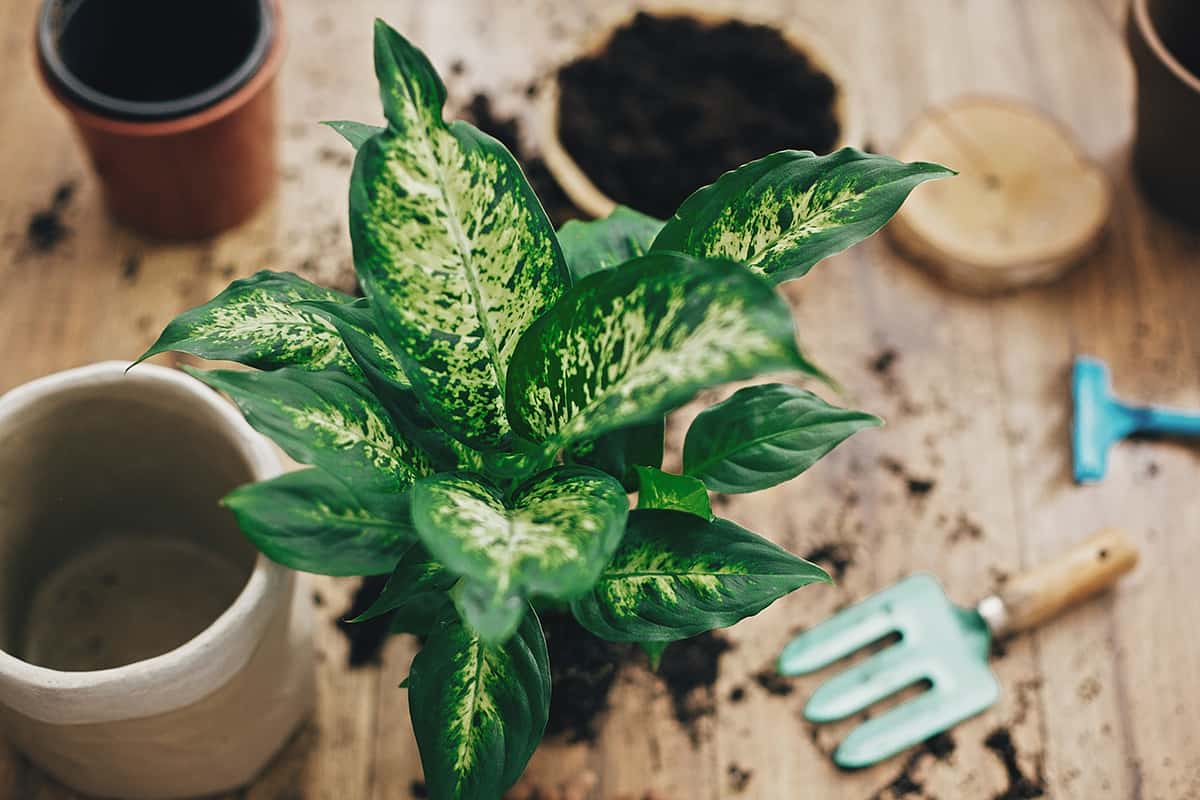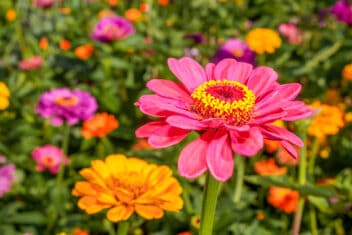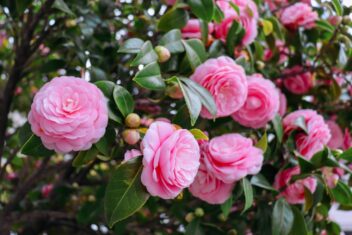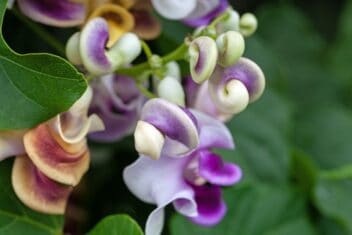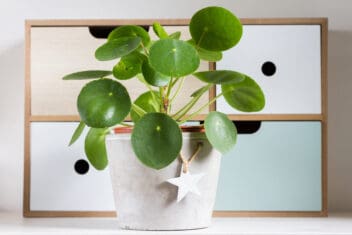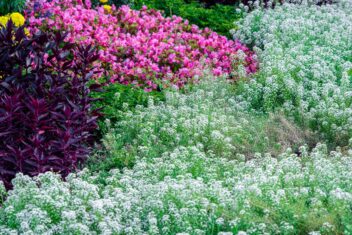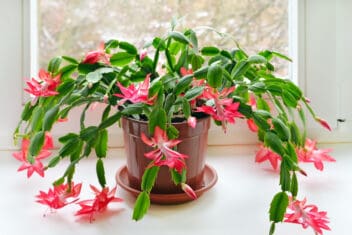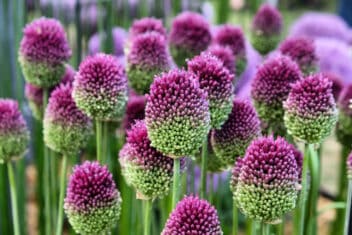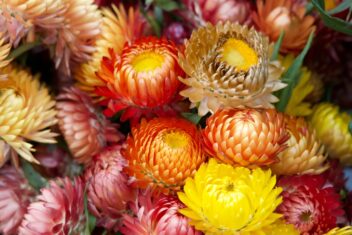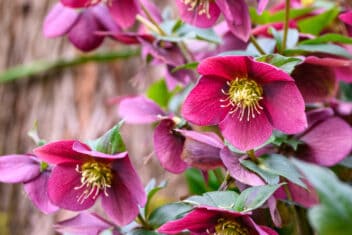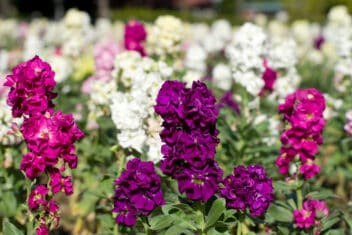I love gardening outside and will plant anything that takes my fancy. I don’t care how complicated my garden choices are to grow. It’s the opposite for houseplants. I have two criteria. I want them to be super-easy to care for and I want them to look good.
Dumb cane fits both of those easily. I have seen this plant in houses, offices, RVs, and everywhere in between. It’s so popular because it’s incredibly tolerant of a range of conditions and is relatively unbothered by pests and diseases.
What is Dumb Cane?
Dumb cane, or dieffenbachia, is a common houseplant that has a bad reputation we need to address first. It’s said to be seriously dangerous to humans. It’s true that dumb cane is toxic if you eat it, and people have reportedly used it throughout history to end their lives or to kill others.
One man made the mistake of taking a bite, likely mistaking it for another plant, and a tracheostomy was necessary to help him breathe again.
But modern reports show that it is rarely fatal because most people know to take care around it. Still, it can be dangerous.
For most people, the most common symptoms are a swollen and painful mouth, or the paralyzation of the vocal cords (rending the person mute). This numbness, pain, and swelling are caused by calcium oxalate crystals in the plant’s tissue.
In fact, that’s where the name comes from. When someone ingests those crystals, they release histamines. Chewing the plant will irritate the mucous membrane of your mouth and throat, causing the swelling and the inability to talk.
The effects are so potent that just getting some sap on your hands and accidentally touching your mouth can cause symptoms.
In other words, use caution when working with dumb cane! And keep curious pets far away.
Dieffenbachia is a genus of dozens of species of plants, including pica, amoena, and seguine. All of these plants tolerate some dryness and a little neglect. They love the climate of indoor environments and don’t need a lot of light, so they even suit those darker interiors.
Varieties of Dumb Cane
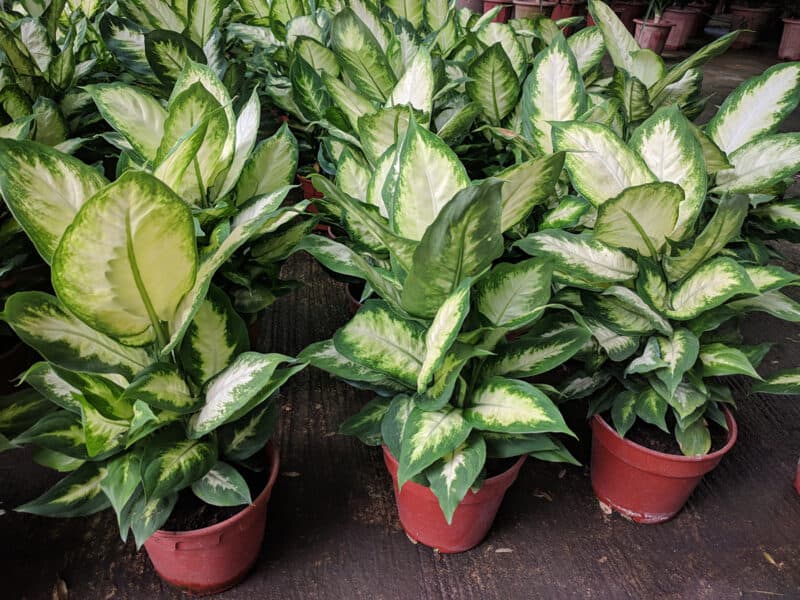
This list can go on forever, so I’ll cover the popular ones most likely available in your average home store or nursery.
Camilla
D. bowmannii ‘Camilla’ is an attractive specimen with dark green leaves at the edges, moving to white toward the center. ‘Camille’ prefers a shady or darker spot where it won’t get hit with direct light.
Tropic Snow
D. amoena ‘Tropic Snow’ makes a statement because it’s one of the bigger dieffenbachia available. A happy tropic snow will give you height and lots of foliage. I’ve seen them reach 10 feet tall.
The leaves are large, deep green, and oblong with cream or white accents.
Exotica
D. picta ‘Exotica’ is extremely popular. The leaves are green on the outside with a mostly white center. This will grow to around 5 feet if you want it to.
D. oerstedii
If you want an all-green variety, this species is an excellent option to take a look at. It’s native to Central Mexico and some places in Ecuador, with solid green foliage.
Tropic Marianne
D. bowmannii ‘Tropic Marianne’ is a serious contender for house plant boss. Its leaves can be a huge two feet across.
How to Plant Dumb Cane
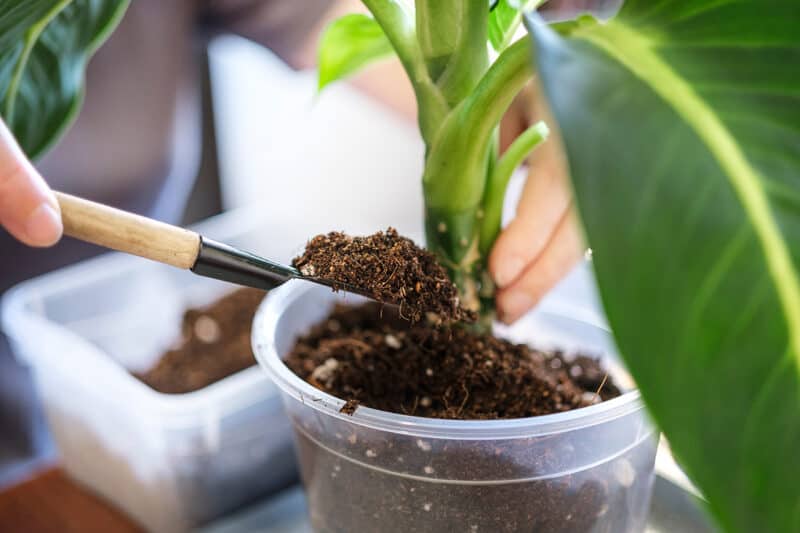
Dumb cane likes warmth, so it suits most homes provided you keep your rooms heated during cold weather. If it’s in a room that is unheated or too cool, it will struggle or die.
Between 60-80ºF is best. Anything below 50ºF is too cool for dumb cane. The leaves will turn yellow and drop off the plant.
Cool winds are also a deal-breaker. The odd breeze is fine, like when you open a door, but a constant cool breeze also makes the leaves go yellow and drop off. Keep them away from single-pane windows in the winter and AC vents in the summer.
Use a good quality potting mix that drains well but holds moisture.
In USDA Growing Zones 10 and 11, you can grow dumb cane outside, but the temperature must be consistent. It will also need feeding every few months during the growing season.
Propagation by Cuttings
Remember my criteria of easy? Well, propagation of dumb cane is super simple.
Look at an older dumb cane and you often see stems or bare canes at the base of the plant. As these plants age, they lose some of the leaves at the base, and new foliage forms at the top. These older, bare canes are what you can use to make new plants.
Cut these canes off the plant slightly above soil level. Slice these into four-inch pieces. Each piece should have at least one node on it (these look like rings).
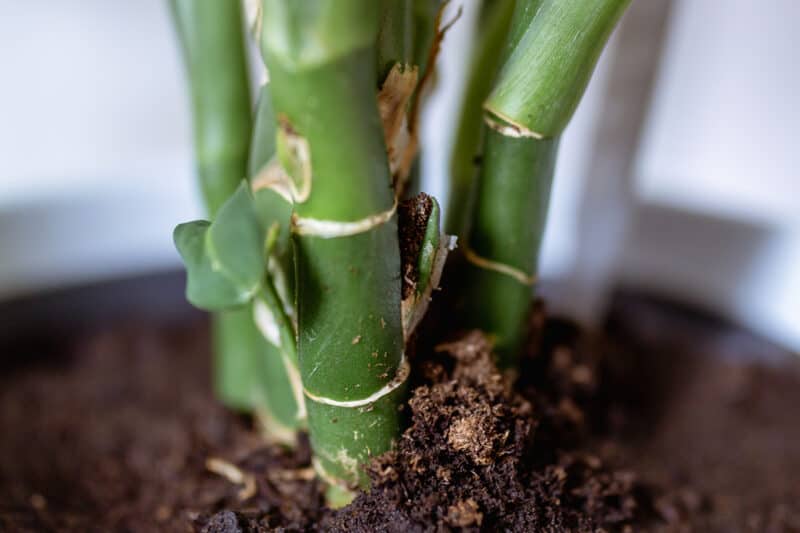
Push these two inches deep into seed raising mix. Place in an area with bright, indirect light. Water well and keep the soil moist for several weeks.
Within a few weeks, you will see new growth at the top of the cutting. This is now a new plant.
You could also take a cutting by taking the growing 6-inch tip of a healthy plant. Remove the lower leaves but retain the top ones.
Plant this two inches deep in seed raising mix and spray with a misting bottle, keeping the medium moist until new roots form. You can tell this has happened if you give the plant a little tug and it resists.
Root in Water
This is by far the easiest way and the method I prefer. Just keep in mind that plants rooted in water tend to have a weaker root system and they’ll need time to adjust to the soil when you transplant them.
Cut a six-inch stem and remove the lower leaves. Place this in a glass or jar filled with water. Change the water every week until the roots appear.
Once roots have formed, plant in a peat-based potting medium. You want to do this before too many roots form in the water because the longer you leave the roots to grow, the less likely they will take in the medium.
Caring for Dumb Cane
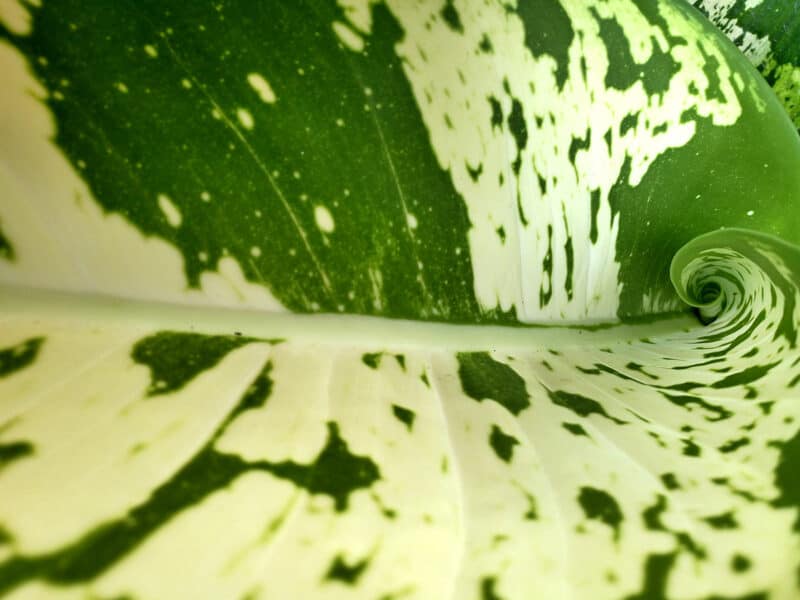
Use a balanced fertilizer (20-20-20) and feed your dumb cane every twelve weeks except in the winter. Alternately, use a slow-release fertilizer in the spring.
If your dumb cane is growing in bright light, it needs more fertilizer than one growing in limited light.
You are after a balance of keeping the plant healthy and getting the dumb cane to grow slowly and retain a good shape.
Keep the soil in the container moist. Give the pot a thorough watering, then hold off until just the surface gets dry. Spray occasionally with a fine mist.
Dumb cane will tolerate most lighting conditions, but the darker the area in your house, the slower the growth will be. Don’t put it in full sun, though, as that is a little too hot for it and dries out the soil too quickly. These plants like a bit of humidity.
As dumb canes mature, they drop their lower leaves. This makes them look a bit like a palm. If you don’t want that look, you can cut the plant to your desired height and this will cause the dumb cane to sprout new growth.
You can prune to shape and height any time.
Companion Planting for Growing Dumb Cane
The following plants can grow in the same location as dumb cane because they have similar growing requirements.
- Dragon tree
- Chinese evergreen
- Cast iron plant
- Boston fern
- Spider plant
Common Problems and Solutions for Growing Dumb Cane
Dumb cane really is an easy plant to grow, however, sometimes things go wrong.
Leaves Yellow and Fall Off
This is usually due to overwatering. The medium should be kept moist, but not soaking. Also, make sure you use a pot that can drain the water away.
Make sure there is no cool draft where you’ve positioned the pot and the temperature of the room is sufficient.
If all that checks out, it could be a fungal issue. Treat with a copper-based spray.
Stem Rot Disease
This is a fungus infection that affects the stem. When you overwater and the dumb cane is in temperatures that are too cool, this disease can strike.
Remove the infected stems. If the upper portion of the stem is okay, you can use it to propagate new plants.
Red Spider Mites
Dumb cane quite likes humidity. When the humidity is low, spider mites can become a problem. They feed on the sap in the plant and cover the dumb cane in webbing.
The first sign is usually sticky webbing. Then you’ll see little brown dots on mottled leaves. This is the cells of the leaves dying after the red spider mites have pierced them and sucked the goodness out of the plant.
If you don’t address red spider mites reasonably quickly, you can have problems eradicating them.
Spider mites hate water and humidity so spray the foliage with a misting bottle to increase humidity. Wipe the leaves with a damp cloth as well. An insecticidal soap can help you wipe them out.
Scale
These little creatures are annoying and it usually takes a few treatments to rid your plant of them.
The first sign of scale if you haven’t noticed the creatures themselves is the sticky honeydew they excrete which turns to a black sooty mold.
Dab them with a cotton swab dipped in rubbing alcohol and you may have to scrape them off gently as well.
Fungus Gnats
These little flying bugs are as annoying as fruit flies buzzing around your head. They don’t cause a lot of damage, but you often find them around the base of the plant since they live in moist soil.
Make sure you remove any foliage that drops onto the soil and don’t overwater the container.
Thrips
Thrips on your houseplant are irritating and damaging, and you should deal with them as soon as you can. See our guide on thrips for more information.
Tips for Growing Dumb Cane Well
Here are some helpful tips for the healthiest dumb cane plant.
Inside
- Use a pot a few inches wider than the container the plant came in.
- Fill the pot with good quality potting mix.
- If your dumb cane is struggling, feed regularly in spring to fall and move into a sunnier spot.
- Repot the dumb cane into a bigger container if becomes too top heavy.
Outside
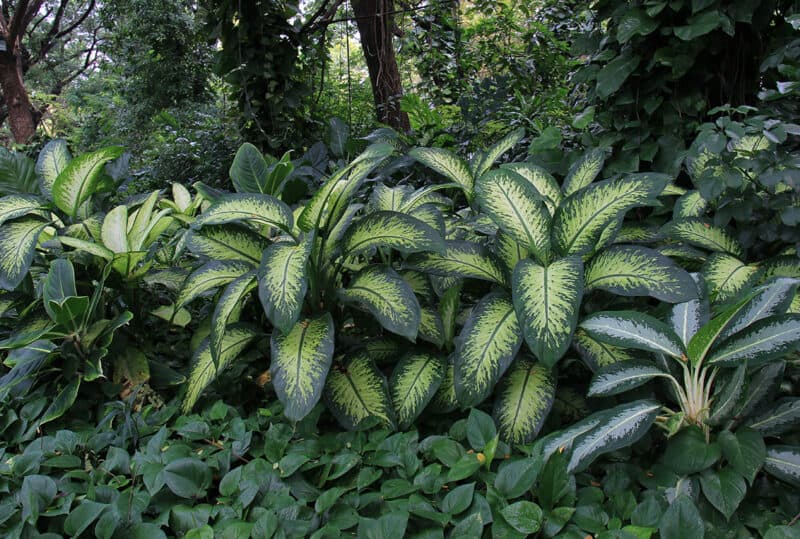
- Dig in plenty of well-rotted compost before planting.
- Use seaweed based fertilizer.
- Mulch in hot weather to retain moisture.
- Divide clumps and replant.
- Don’t plant in full sun and protect from wind.
